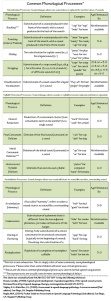Interview Questions:
- How are they doing in school?
- Are they able to be understood by an unfamiliar listener?
- Are they able to communicate and interact with their peers?
- What percentage of your child’s speech would you say you, as parents and familiar listeners, are able to understand?
- Are there specific sounds/words you notice your child struggles with?
Formal Tests:
- Goldman-Fristoe Test of Articulation (GFTA)
- Hodson Assessment of Phonological Processes (HAPP)
- Clinical Assessment of Articulation and Phonology (CAAP)
- Comprehensive Test of Phonological Processing (CTOPP)
- The Apraxia Profile
- Screening Test for Developmental Apraxia of Speech (STDAS)
- Kaufman Speech Praxis Test (KSPT) for Children – to determine presence of motor speech problems
*Screen for language as well since there is a high correlation of language problems and phonological deficits*
Informal Assessment Tools:
- Speech sample – reading sample or play
- Speech sound inventory – determine patterns of error
- Probe for different abilities and stimulability of different sounds

http://www.playingwithwords365.com/2011/09/phonological-processes-and-phonological-delay/

http://ilovecharts.tumblr.com/post/3424671278/these-are-the-typical-ages-by-which-children-in
| Verbal Apraxia | Phonological Disorder |
| No weakness, incoordination or paralysis of speech musculature | No weakness, incoordination or paralysis of speech musculature |
| No difficulty with involuntary motor control for chewing, swallowing, etc. unless there is also an oral apraxia | No difficulty with involuntary motor control for chewing and swallowing |
| Inconsistencies in articulation performances – the same word may be produced several different ways | Consistent errors that can usually be grouped into categories (fronting, stopping, etc.) |
| Errors include substitutions, omissions, additions and repetitions, frequently includes simplification of word forms. Tendency for omissions in initial position. Tendency to centralize vowels to /ə/ | Errors may include substitutions, omissions, distortions, etc. Omissions in final position more likely than initial position. Vowel distortions not as common. |
| Number of errors increases as length of word/phrase increases | Errors are generally consistent as length of words/phrases increases |
| Well-rehearsed, automatic speech is easiest to produced, while volitional speech is most difficult | No differences in how easily speech is produced based on situation |
| Receptive language skills are usually significantly better than expressive skills | Sometimes differences between receptive and expressive language skills |
| Rate, rhythm and stress of speech are disrupted, some grouping for placement may be noted | Typically no disruption of rate, rhythm or stress |
| Generally good control of pitch and loudness, may have limited inflectional range for speaking | Good control of pitch and loudness, not limited in inflectional range for speaking |
| Age-appropriate voice quality | Age-appropriate voice quality |
Adapted from http://www.apraxia-kids.org/site/apps/nl/content3.asp?c=chKMI0PIIsE&b=788447&ct=464135